Asus ZenBook 15 (UX533F) Review: A powerful, portable performer
Asus ZenBook 15 (UX533F) Review: A powerful, portable performer Review
A powerful, portable performer
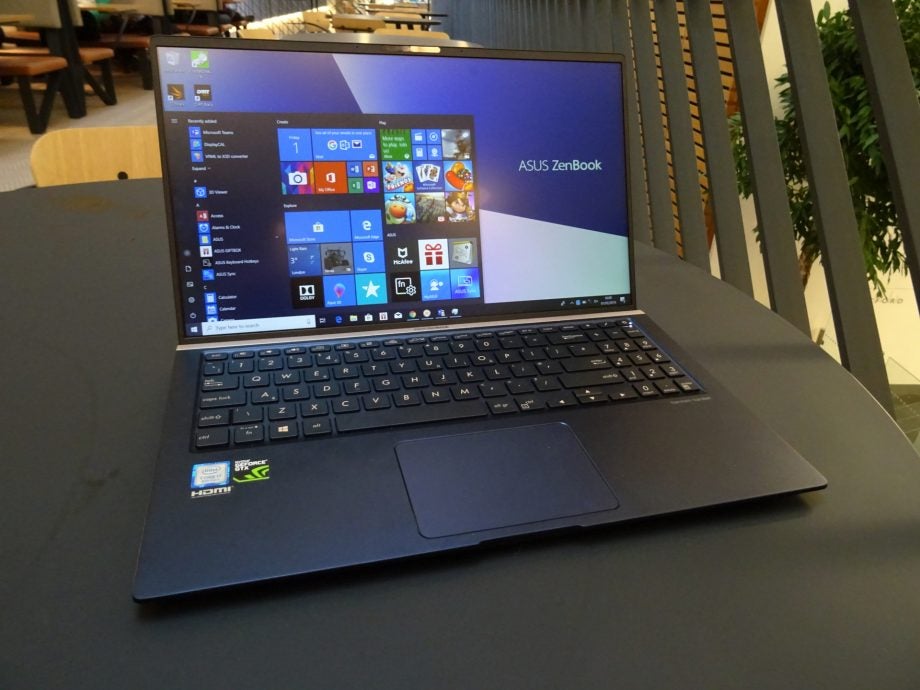
Verdict
Beautiful to look at, powerful, and boasting a long-lasting battery, the ZenBook 15 is an excellent Windows laptop.
Pros
- Solid performance
- Fantastic battery life
- ErgoLift shape makes for easier typing
- Dedicated graphics card
Cons
- Trackpad issues
- Low Adobe RGB and DCI-P3 coverage on anti-glare version
Key Specifications
- Review Price: £1399
- Intel Core i7-8565U and Core i5-8265U
- Intel UHD Graphics 620
- Nvidia GTX 1050 Max-Q, 2GB/4GB GDDR5 VRAM
- 8GB / 16GB 2400MHz DDR4
- 354 x 220 x 17.9mm
- 1.59kg
What is the Asus ZenBook 15 (UX533F)?
The Asus ZenBook 15 (UX533F) is a cheaper, lighter and more mainstream proposal than the heftier, more powerful and designer-focused ZenBook Pro.
It’s one of the first laptops hitting shelves that features an Intel Whiskey Lake processor, which promises improved performance over other 8th gen laptop CPUs and more efficient power use.
In theory, the ZenBook should have enough processing grunt to blitz through your daily tasks while leaving enough power in the tank for you by the end of the day. Here’s how I got on in practice.
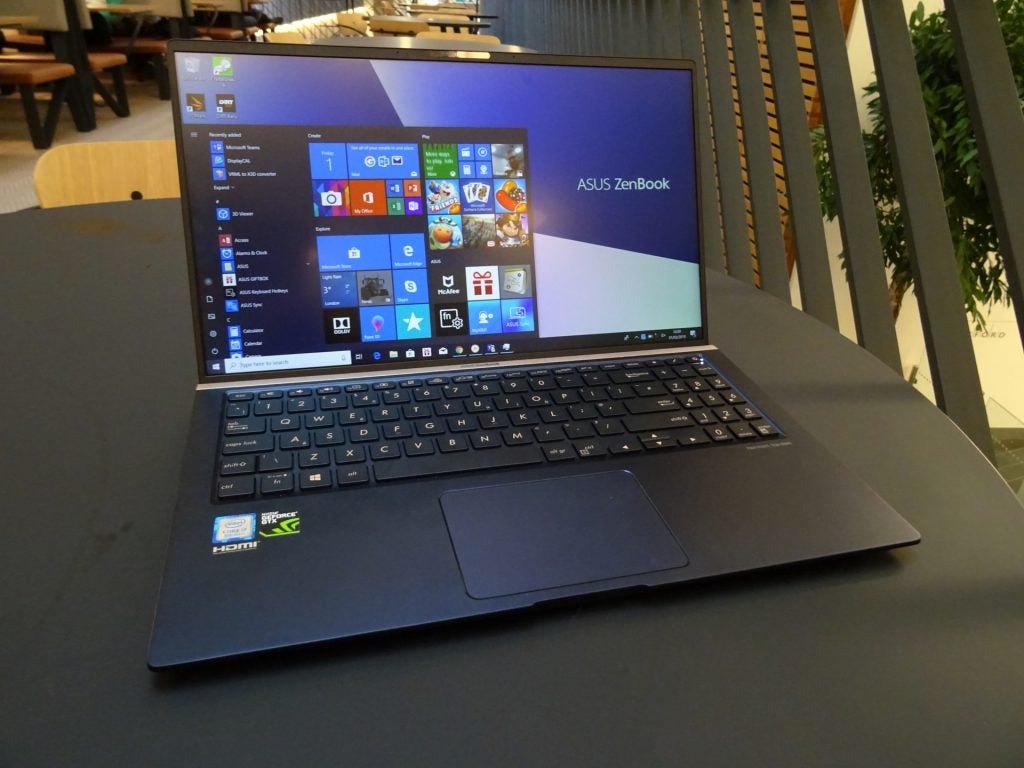
What’s blue, gold, and gorgeous all over? Why, the Asus ZenBook, of course.
Related: Best Laptops 2019
Asus ZenBook 15 (UX533F) – Design and features
The ZenBook, like its bigger ZenBook Pro sibling, is very swish-looking. Our review model featured the same deep blue and rose gold colour combination that stands out nicely from boring old grey and black portable PCs.
The colour of the gold accents is also matched by the lettering on the keys, which is a nice touch that makes the ZenBook look a cut above your average ultrabook.
The first thing you’ll notice when you open up the ZenBook is how thin the bezel is. It’s around 3mm at the sides, 5mm at the top and about 4.5mm at the bottom – Asus claims a screen-to-body ratio of 92% here. It’s certainly very high, to the point where half the time you won’t even notice the edges of the screen.
In Asus branding spiel this is called ‘NanoEdge’, but that’s just a fancy way of saying ‘a very thin bezel’ – it has nothing to do with the quality of the display or nanotechnology or anything like that.
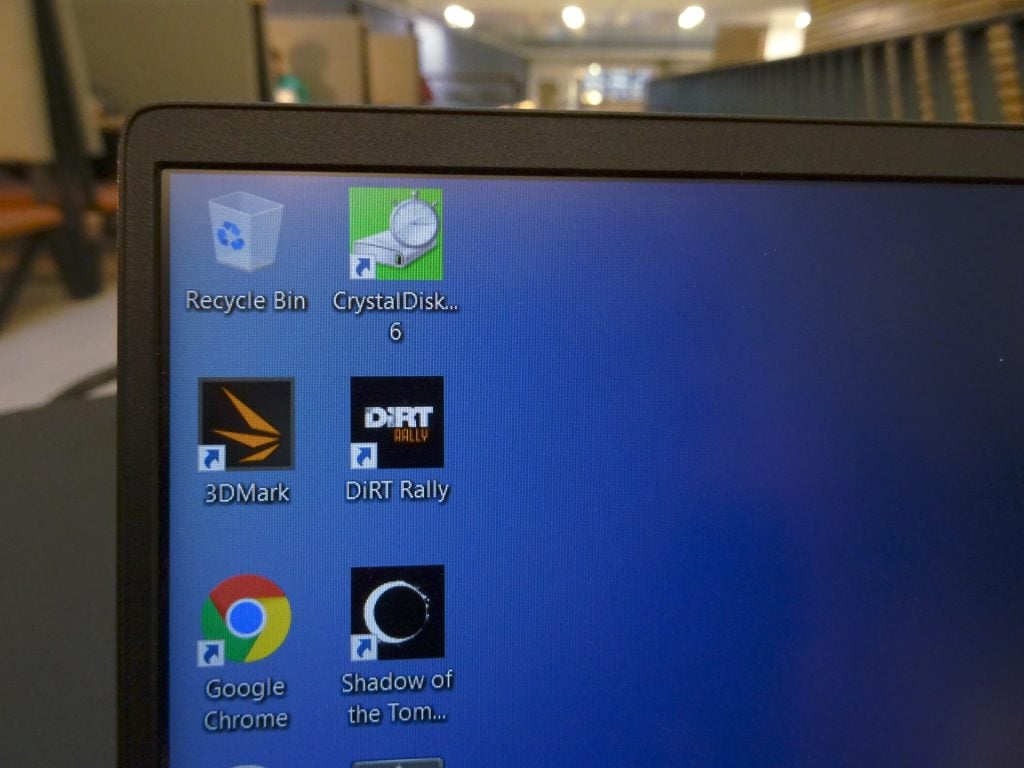
The bezel of the Asus ZenBook 15 (UX533F) is so small, you barely notice it’s there.
Ports-wise, you get two Type-A USB ports (aka ‘the old school rectangular ports’), one Type-C USB (aka ‘the newer, lozenge-shaped ports’), HDMI, an SD card reader and a 3.5mm audio jack.
That’s a good degree of physical connectivity for a laptop which weighs under 2kg (1.59kg) and measures 17.9mm at its thinnest point. It’s up there with the LG Gram 15Z980 in the light-15-inch-laptop-with-lots-of-ports stakes. There’s no Ethernet port, but that’s not so much of a big deal, as Asus has kindly bundled in a USB-A to Ethernet adapter, so you can get wired in easily.
Design quirks of the Asus ZenBook 15 don’t end at skinny bezels. There’s something else called ‘ErgoLift’ too. In practical terms, this means that a portion of the screen’s casing has been designed in such a way that when you open the ZenBook 15, it has the effect of lifting the laptop’s posterior up off of the surface of your desk by an angle of about three degrees.
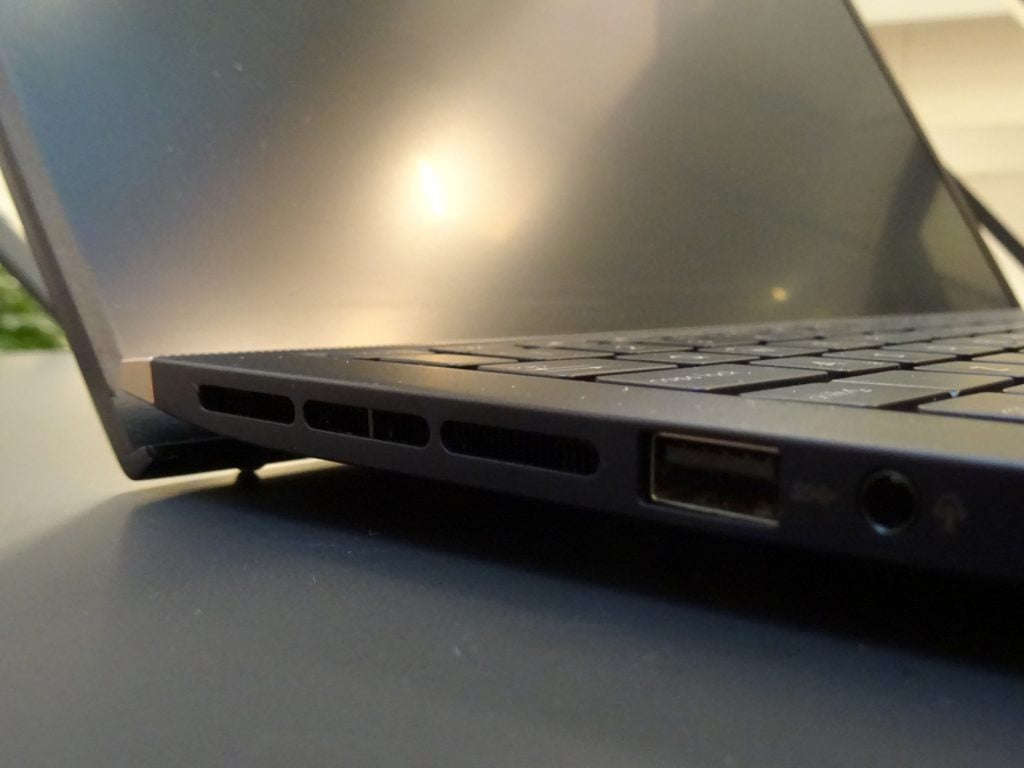
The ErgoLift design in action – see how both the shape of the top half of the Asus ZenBook 15 (UX533F) and the rubberised feet lift the bottom half clear off of the desk.
This sees the keys angled towards your hands, which Asus says makes it more comfortable to type on. I can confirm that the ZenBook is comfortable to type on, but I’m unsure if this is down to the angle of the ErgoLift design or it’s just because the ZenBook 15’s chiclet-style keyboard is a good keyboard.
The trick with the hinge is also intended to improve airflow as the back of the ZenBook’s base isn’t touching the desk, and therefore emitting heat straight into that flat surface. This supposedly has the effect of improving airflow around the laptop’s hot bits.
The main air vent is lifted off of the desk as a result of this, so I’m inclined to see the method on Asus’s madness. Another vent sits on the left side, near the USB-A and 3.5mm ports too, which kicks out extra hot air whenever you’re doing something intensive. In terms of noise, the fans here are pretty quiet. Then again, this isn’t a huge, hulking gaming laptop, so it shouldn’t be kicking out loads on the decibel front anyway.
Speaking of which, the two downward facing Harmon Kardon-certified speakers are a bit of a mixed bag. On the one hand, the sound these things kick out is very good. It passed the ‘Master of Puppets’ test, with bass, drums and guitar sounding crystal clear and nicely separated. TV content streamed from iPlayer and Netflix sounded excellent too. Not every laptop in this price range is capable of kicking out such good quality sound, so this is worth shouting about.
That said, when watching something in bed or on the couch, where the speakers would sometimes be muffled by throws and duvets, some of the sound would be lost – it may have been better if the speakers had been mounted on the topside, so they were actually facing you instead. Doing this though would mean that the keyboard would either be smaller, or the overall chassis wider. This is a very small gripe, because generally the external speakers of the ZenBook are very good.
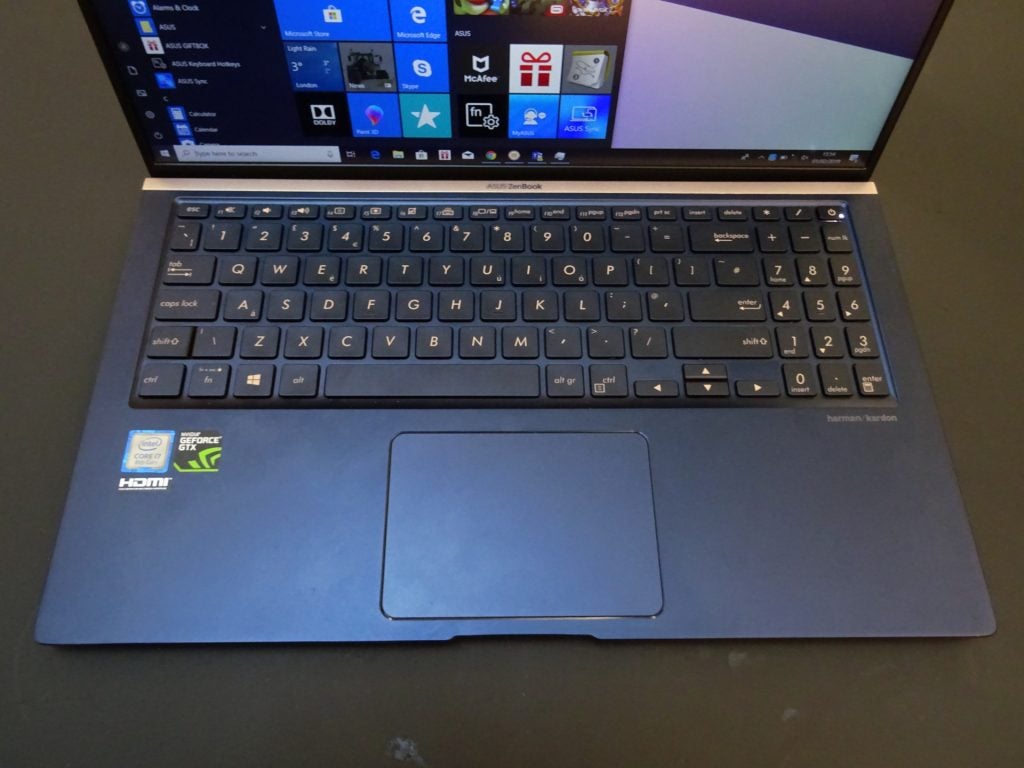
The keyboard’s generally easy to type on, but some of the bigger keys are slightly wobbly.
Related: Best Ultrabooks 2019
Asus ZenBook 15 (UX533F) – Keyboard
As I said above, the Asus ZenBook 15’s keyboard is easy to type on, with the low-travel keycaps firing back nicely, making typing at speeds approaching 100 words a minute possible.
There’s some slight wobble on some keys, especially the longer keys, like Enter and the right-hand Shift key, which makes me wonder about how robust this thing is. It’s maybe not quite as nice or easy to type on as the keyboards of other premium devices, like the 2018 Apple MacBook Pro with the third-gen butterfly switched keycaps, or the 2018 Dell XPS 15 2-in-1, with its maglev keyboard (still our favourite laptop keyboard the time of writing).
In terms of layout, this is a fairly standard QWERTY keyboard conforming to the UK layout – i.e. Shift+3 gives you a ‘£’, and the ‘@’ symbol is where it should be. I was able to comfortably rest my hands on the front of the laptop and get acquainted with the home keys. The same can’t be said for the number keys, which are shunted over to the right-hand side and don’t enjoy the same prominence.
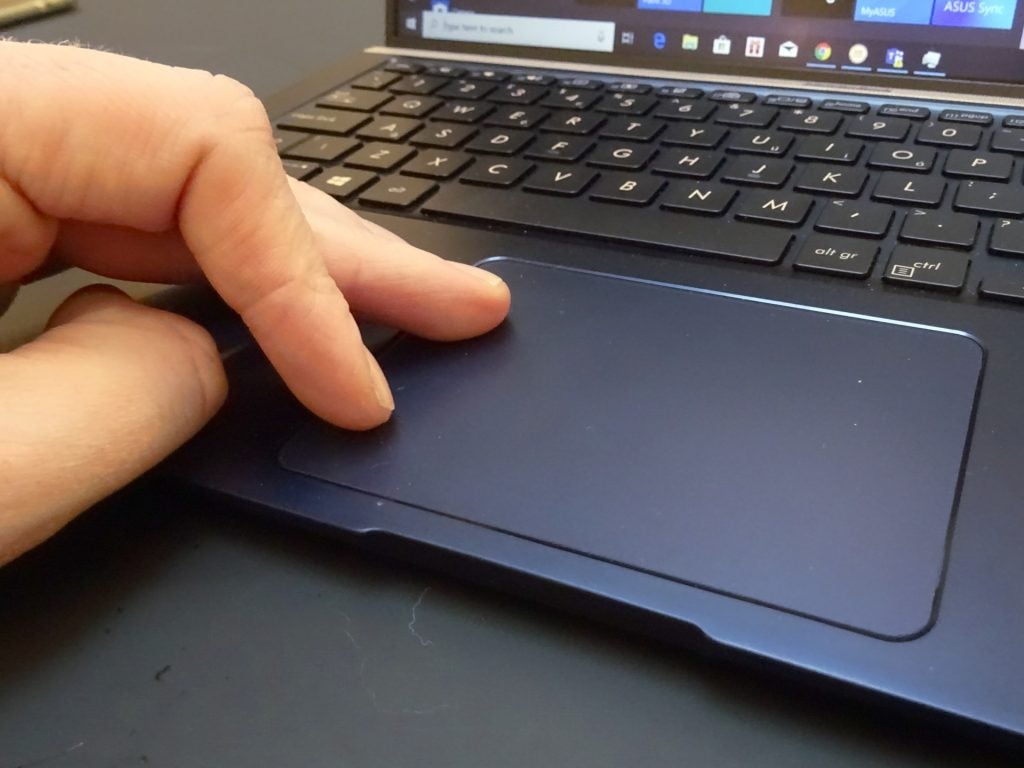
The trackpad of the Asus ZenBook 15 (UX533F) is nicely sized, but I found that it would occasionally hang when I was scrolling through long articles.
I also generally didn’t get on with the size of the Function keys. They’re a little too small for my big old sausage fingers. I’d often find myself hitting the backslash key, which sits very close to the left shift button, when I meant to press Ctrl+Shift+V instead. I feel like these are small gripes though, and with some more ‘bedding in’ time, I’d be able to acclimatise to the ZenBook’s layout easily enough.
I had some issues with the trackpad, which didn’t always respond to commands as quickly as I’d like. After some fiddling around in the settings, things improved, but occasionally I’d find myself attempting to scroll through an article using the two finger gesture and instead find myself clawing in futility at the thing.
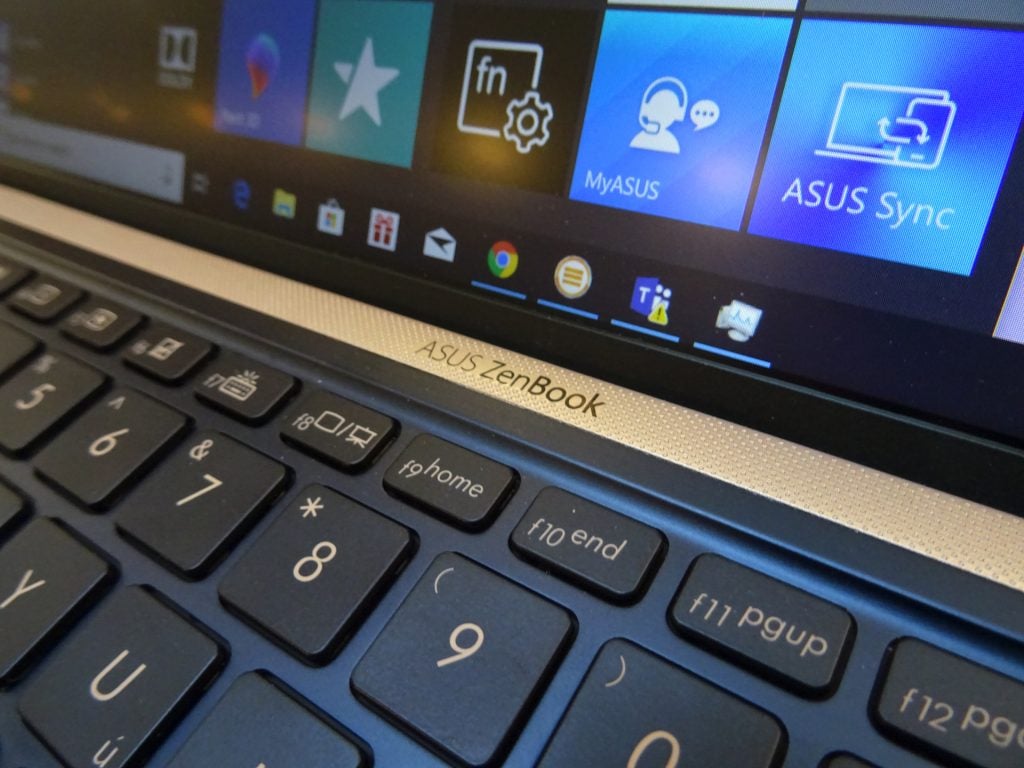
Ambient light is gently reflected by the anti-glare coating.
Related: Best Keyboards 2019
Asus ZenBook 15 (UX533F) – Display
The ZenBook’s 15.6-inch Full HD (1920 x 1080) LCD display comes in two versions: a ‘standard’ version and one with an anti-glare coating – the review unit I picked up was the latter.
Viewing angles on the model I tested were excellent, the horizontal angles more so than the verticals, but never at any point when working away on the ZenBook did I have to squint or crank the brightness up in order to get a better look at what I was working on.
In terms of colour space coverage, I recorded some respectable but not amazing numbers – out of the box, the ZenBook covered 80.2% of the sRGB gamut, which is fine for graphic design work, but it covered a sub-standard 58.6% and 64.9% of the Adobe RGB and DCI P3 spaces. This means that the ZenBook is not an ideal laptop of choice for serious photo editing work.
If you need something for light photo editing, this will suit you just fine in a pinch – I found that freeware photo editing program GIMP worked a treat. Thanks in part to good read and write speeds and an Nvidia GTX 1050 beavering away under the hood, large 5184 x 3888 photos loaded almost instantly, so if you’re resizing photos for websites, you’ll be fine – just don’t expect to do any work on photos intended for professional printing here.
Without having a model without the anti-glare coating at hand to compare, I can’t say how things might be better with regards to colour space coverage. My hunch is, seeing as displays with such coatings tend to result in narrower coverage, taking a ZenBook with the standard anti-glare coating-free display should result in better colour gamut readings, but I can’t say this for sure right now.
Again, while you might not want to do serious video editing on this, it’s more than good enough for stretching back on your couch and streaming the latest episodes of True Detective.
Asus ZenBook 15 (UX533F) – Specifications
| Asus ZenBook 15 (UX533F) | |
| Dimensions | 179 x 354 x 22.0 mm |
| Weight | 1.59kg (3.50 lbs) / 1.69kg (3.72 lbs) |
| Display | 15.6-inch Full HD (1920 x 1080) LCD with or without anti-glare coating |
| Processor | Intel Core i5-8265U quad core CPU clocked to 1.6 GHz (turbos to 3.9GHz), 6MB cache / Intel Core i7-8565U quad core CPU clocked to 1.8GHz (turbos to 4.6GHz), 8MB cache |
| Memory | 8GB / 16GB 2400MHz |
| Graphics | Intel UHD Graphics 620, Nvidia GeForce GTX 1050 with 2GB / 4GB GDDR5 VRAM |
| Storage | 256GB / 512GB / 1TB PCIe 3.0 SSD |
| Connectivity | Dual band gigabit-class Wi-Fi ac, Bluetooth 5.0 |
| Ports | 1 x Type-C USB 3.1 Gen 2 (up to 10Gbps) with display support, 1 x Type-A USB 3.1 (up to 10Gbps), 1 x Type-A USB 3.1 (up to 5Gbps), 1 x HDMI, 1 x SD card reader, 3.5mm headphone jack |
| Camera, mics, speakers | 720p front camera with IR sensors and Windows Hello |
Asus ZenBook 15 (UX533F) – Performance
The ZenBook 15 model I received featured a Core i7-8565U CPU, 16GB of RAM and 512GB of storage (476GB of which is user-available from fresh).
The benchmark scores below indicate a laptop that’s more than capable at handling everyday tasks and in the days I’ve been using it tore through photo editing, loading several large 5MB photos in GIMP quickly, while streaming Spotify playlists and juggling convos in Microsoft Teams – and all with no slowdown.
| Asus ZenBook 15 (UX533F) | LG Gram (15Z980) | Asus ZenBook Pro 15 (UX580GE-XB74T) | |
| PC Mark* | 4038 | 3149 | 5325 |
| Geekbench 4 single-core | 5166 | 4687 | 5201 |
| Geekbench 4 multi-core | 17378 | 12282 | 23194 |
| Disk read speeds | 1737.8 MB/sec | 549 MB/sec | 2341.1MB/sec |
| Disk write speeds | 1407.9 MB/sec | 448 MB/sec | 1269.2MB/sec |
| Cinebench Open GL | 105.54 fps | TBC | 121.67fps |
| Cinebench cb | 843 | TBC | 1199 |
*Note that the LG Gram 15 was reviewed when Trusted Reviews used PC Mark 8 to benchmark laptops. Trusted Reviews now uses PC Mark 10 – we will re-test the LG Gram and update this review.
PC Mark 10 is a general test of a PC system that simulates a range of everyday work tasks like web browsing, video calling and word processing. A score of 4038 indicates that the ZenBook is a solid workhorse, especially for such a small and lightweight laptop. Typically, a score of 4500 or higher suggests a powerful, high-functioning device.
Geekbench 4 is a CPU stress test that’s only really useful as measure of a processor’s performance. For general reference, a single core score of over 4000 is considered good, while a score of 8000 for multi core performance is the baseline mark for a solid performer.
The Geekbench results here were astoundingly good, outperforming the majority of the laptops I’ve tested in the past year. That said, since the Asus ZenBook 15 is the first laptop I’ve tested with Intel’s latest 8th Gen CPUs for laptops, it’s hard for me to say how those Geekbench figures will fare with the 2019 competition.
For now, I’m mainly comparing the ZenBook 15 to the LG Gram 15, another 15-inch laptop that’s similarly specced and priced, as well as the Asus ZenBook Pro 15.
Disk read and write speeds are good, about what I’d expect to see on a current day laptop for this price, but increasingly, I’m seeing more and more laptops beating speeds like this. In practical terms, this means that you’ll be able to launch games in a matter of seconds instead of minutes, and sling 20+ photos into GIMP and have them all open quickly.
The ZenBook 15 is not a gaming laptop first and foremost, and so its GPU performance is not going to compare favourably with things like last year’s Razer Blade 15, nor any of the upcoming 2019 laptops that’ll feature 20 Series Nvidia GPU, like the Lenovo Legion Y740, the Dell Alienware m17, or even the Asus Zephyrus S GX701.
That said, the ZenBook 15 has got an Nvidia GeForce GTX 1050 graphics card and you can get up to 16GB of DDR4 RAM here. While you won’t be able to play newer titles with real-time ray tracing turned on, you might be tempted pick this up of you wanted to do a bit of gaming on the side.
I ran the 3D Mark Firestrike test, the basic benchmarking tool Trusted Reviews uses for laptops with dedicated graphics cards and Ice Storm, a less-demanding benchmark which we use to test devices with integrated graphics (like the LG Gram).
While the ZenBook has dedicated graphics (the Nvidia GeForce GTX 1050), I ran this to demonstrate the benefits of picking up an ultrabook with a dGPU, in case anyone who wants a work machine with a sideline in casual gaming is tempted to go for a cheaper option with integrated graphics.
In the table below I’ve added results from fully fledged gaming laptops like the Asus ROG GL504 Hero II and Razer Blade 15 (2018) to give you a broader idea of how this stands up to what’s out there right now:
| Asus ZenBook 15 (UX533F) | LG Gram (15Z980) | Asus ZenBook Pro 15 (UX580GE-XB74T) | Asus ROG GL504 Hero II | Razer Blade 15 (2018) | |
| 3D Mark Ice Storm | 75148 | 64544 | n/a | n/a | n/a |
| 3D Mark Firestrike | 5060 | 1003 | 5325 | 10115 | 11624 |
I also ran in-game benchmarks in Full HD (1920 x 1080) for Shadow of Mordor, DiRT Rally and Shadow of the Tomb Raider, to give you an idea of how the ZenBook copes with a range of newer, more demanding titles, and older games.
On average, Shadow of Mordor skirted around the 60fps mark on Ultra settings (59.22fps), and managed a more comfortable 60.11fps on High settings and 62.56fps on Medium. DiRT Rally gave me 40.34fps at Ultra, but dropping down to Very High and Medium saw average frame rates climb to 55.46fps and 75.17fps respectively.
Shadow of the Tomb Raider was another story. A much more graphically demanding title, the benchmark wouldn’t give an average frames per second rate above 30 until I dipped the texture and graphics settings all the way down to Low. Going one notch further (‘Lowest’) gave me 38fps.
At Medium and High, I recorded 24fps and 19fps respectively, and the ZenBook 15 audibly struggled here. It wouldn’t even load the Tomb Raider benchmark on Ultra settings at all.
In short, the ZenBook 15 will run all but the most GPU-sapping titles reasonably well – it’ll be absolutely fine for Fortnite – but if you want to be able to play anything at a reasonable frame rate, you’re going to have to do away with fancy texture packs. If cutting edge laptop gaming is a priority, this isn’t the laptop for you.

Low travel of around 1.4,mm makes for fast and easy typing on the Zenbook.
Asus ZenBook 15 (UX533F) – Battery life
The ZenBook 15’s battery gave us an impressive 11 hours and 10 minutes when we used the Powermark benchmark tool to simulate a typical working day – ten minutes of web browsing and 5 minutes of video.
11 hours and 10 minutes is an excellent result, considerably better than what I saw with the (more powerful and therefore thirstier) 2018 Asus ZenBook Pro 15, which only managed a dismal four hours and 45 minutes.
To round this out, I looped a 2 minute 4K video on VLC, with the ZenBook’s screen set to 150 nits and made a note of how quickly power levels fell by. Generally, it’d drop by around 10% every hour until it was completely dead – I counted 10 hours and 35 minutes.
Those whose working day means writing reports, articles, essays, pivot tables and the like will love the amount of juice you can wring out of the ZenBook on a single charge. It’s up there with the LG Gram 15 and HP EliteBook 1050 G1, which give you 12 hours and 11 hours 32 minutes of power, respectively.
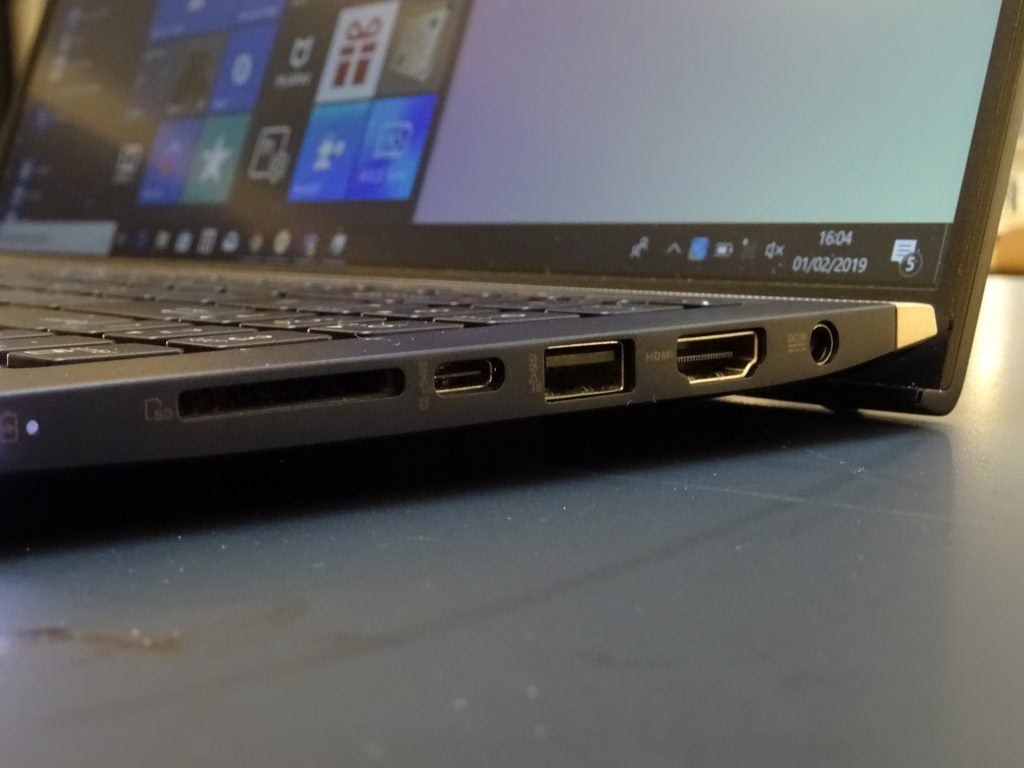
Solid performance combined with good connectivity – L-R, SD card reader, USB-C, USB-A, HDMI, power – and a light sub-2kg build make the ZenBook an attractive option for mobile workers.
Why buy the Asus ZenBook 15 (UX533F)?
The Asus ZenBook 15 is a smart-looking and versatile Windows 10 laptop. It’s got enough ports included so you won’t have to shell out for a load of dongles in order for you to your work done, and the one drawback in terms of physical connectivity – the lack of an Ethernet port – is mitigated by the fact that you get a USB-A-to-Ethernet adapter in the box.
The version I’ve reviewed costs £1399.99. This compares very favourably with the 2018 Apple MacBook Air, which costs the same, has a smaller (albeit higher resolution) display, far fewer ports and a less powerful processor.
It also competes well with the LG Gram 15, which is similarly priced, again, has a slower processor, doesn’t have dedicated graphics, and in terms of storage is limited to 512GB – you can pick up a 1TB version of the ZenBook 15 if you want a bigger SSD on your device. But at the time of writing, only one configuration is available to buy in the UK from Asus and retailers including Newegg, Very and AO – the version I’ve reviewed. I’ll update this review once more information on different versions is available.
That said, there are plenty of compelling reasons to pick this Asus ZenBook 15 (UX533F) right now. Gaming is the cherry on top of a versatile package. And while this isn’t a certified gaming machine capable of blasting through modern AAA titles, it will happily handle older, less demanding games. If you plan on gaming on your laptop more than working, though, you might want to check out the current crop of the best gaming laptops here instead.
Verdict
A smart-looking and capable daily driver that’s a compelling alternative to the LG Gram.
How we test laptops
Unlike other sites, we test every laptop we review thoroughly over an extended period of time. We use industry standard tests to compare features properly. We’ll always tell you what we find. We never, ever, accept money to review a product.


